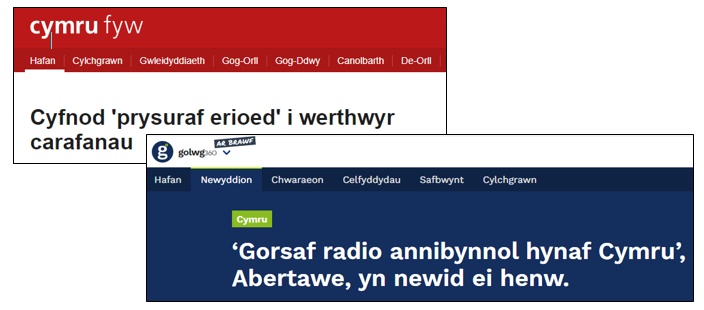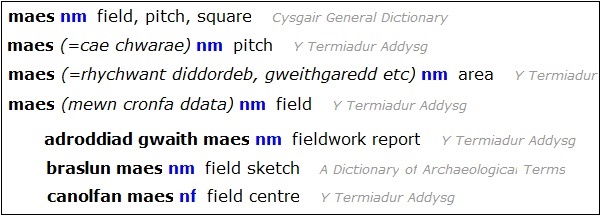Structure of the course
The course is organised as a series of sessions which can be accessed by links from the list alongside.
You are welcome to make use of the material in whatever ways are helpful and no registration is required. However, if you wish to register we will create an account to store your written work so that it may be accessed later or downloaded. There is no charge for this service. Please note that any account not used for six months will be automatically deleted.
Each session is displayed as a single page divided into the series of activities described below:
Language notes
It is perfectly possible to become a fluent Welsh speaker with no formal knowledge of grammar, as amply demonstrated by children brought up in Welsh speaking families or attending Welsh medium schools. However, familiarity with the rules of grammar can be a great help when writing in Welsh. Grammatical rules are simply statements of the accepted patterns for use of the language. Exceptions to the rules are found, and can often be remembered as quirky special cases. Each session begins with an outline of a particular aspect of grammar, such as details of a particular verb tense.
Mutations (Treigladau)
A particular difficulty when writing grammatically correct Welsh is the system of mutations or treigladau. This is an important feature of Welsh and other Celtic languages. Treigladau in Welsh can change the initial letters of many words, including nouns, adjectives and verbs, under a variety of circumstances according to grammatical rules. In this section, we provide notes on the use of treigladau.
Idioms
In each session we present a small selection of commonly used phrases which cannot be translated directly between English and Welsh.
Sentences
You are invited to translate a series of sentences from English into Welsh. Click a button to check your answer, then move on to the next sentence. The examples will generally focus on the topic introduced in the language notes.
Article text
A short article on an aspect of Wales or Welsh life is given in English. You are invited to translate this into Welsh. A button allows you to check your work after each sentence, or on completion. The text will extend beyond the grammatical topic introduced earlier to include additional sentence patterns, and will be an opportunity to develop new vocabulary.
Story
This section is based on the 'Story Cubes' concept, developed to help students improve their literacy and creative writing skills. A set of special dice are thrown, with each face depicting an icon. The student must then compose a story incorporating each of the icons. In our version, a set of icons is generated randomly by the computer program, for example:

Icons may be interpreted in any reasonable way. For example, the elephant may represent an actual elephant (seen in a zoo) or may represent a quality such as huge size and weight (possessed by an object), or long memory (possessed by a character). A story has been written for you using the icons, and you are invited to translate this from English into Welsh.
There is also an option to randomly select a set of icons. You then have the challenge of using these, in any order, to construct your own story in Welsh.
Use of Welsh
This section contains a variety of realistic everyday applications of Welsh language, such as:
Posters
Information and instruction leaflets
Forms and questionnaires
Articles for a newsletter, magazine or web page.
The context of the application will be explained, and you will be given the English content. You are then invited to produce a Welsh language version.
Description
The next section provides an opportunity for a small amount of free writing. You will be shown a photograph and are asked to write about 4 sentences describing the picture. This might be, for example, a place, an object, or a person carrying out some activity.
Press a button to read suggestions for describing the picture.
Understanding Welsh
Finally, we provide a written article in Welsh. You are invited to write sentences in Welsh to answer a series of questions based on the article.
Reading and speaking practice
After writing a document in Welsh, it is sometimes necessary to read this to a Welsh speaking audience, for example: to deliver a report to a town council or give a presentation to a local history society.At the end of each session we provide an audio activity in Welsh. The suggested answers to the translation exercises will be displayed on screen and read out. You are invited to read along with the speaker, or pause the recording and repeat the sentences.
Gender of nouns
Applying a correct
treiglad often depends on knowing whether a noun has
masculine or
feminine gender.
The allocation of gender to nouns in Welsh does not generally follow any logical rules, so gender can only be decided from memory or by referring to a dictionary.
To help in completing the exercises, a list of the feminine nouns used in the course can be displayed by clicking a button at the start of the exercise. Nouns not appearing in the list may be assumed to be masculine.
Nouns referring to people, where gender is obvious, have been omitted from the list. Examples are: merch (girl), athrawes (female teacher), and myfyrwraig (female student).




